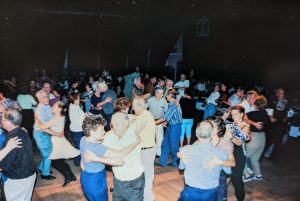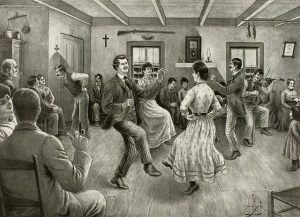Swing Your Partner ’Round and ’Round: Dance Parties
Chaîné bras droit, chaîné bras gauche, coupé en six, en quatre, en deux… Today, these expressions have little meaning to most people. But anyone who lived in Montmagny between the 1960s and the 1980s would immediately associate them with local dances.
Gala in Saint-Eugène (L’Islet), 1998. Watch the video with description (EN).
In the Montmagny region, traditional dance parties were organized almost every Friday and Saturday. Alongside an accordionist, a guitarist, a pianist and a fiddler, there would be a caller who announced the steps for dancers to follow. These events were rooted in a tradition dating to New France, but that had incorporated various other influences during the British regime. Dance parties provided opportunities for both artistic expression and social integration, since experienced dancers and novices alike could participate. Although many dances were popular throughout Quebec, some were specific to certain regions.
Listen as Armand Labrecque describes the different dances participants would perform over the course of an evening:
Listen to the interview (FR) with transcript (EN).
Where Does the Accordion Fit In?
In many regions of Quebec, the fiddle was normally the star of a traditional dance party. But in the Montmagny area, the accordion tended to take pride of place. Locals appreciated the instrument’s acoustic power as well as its affordability. As for the fiddle, some dismissed it as an “old man’s instrument.”
Armand Labrecque talks about the significance of the accordeon:



